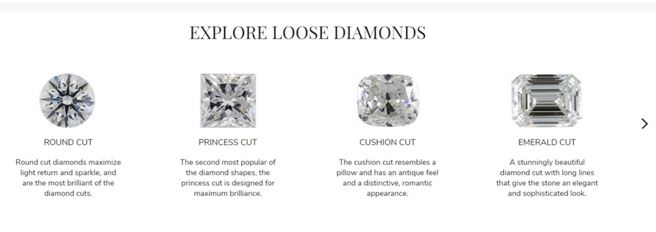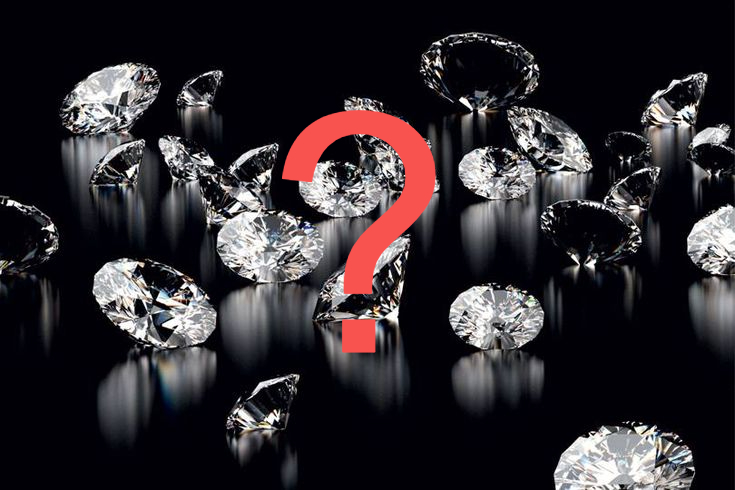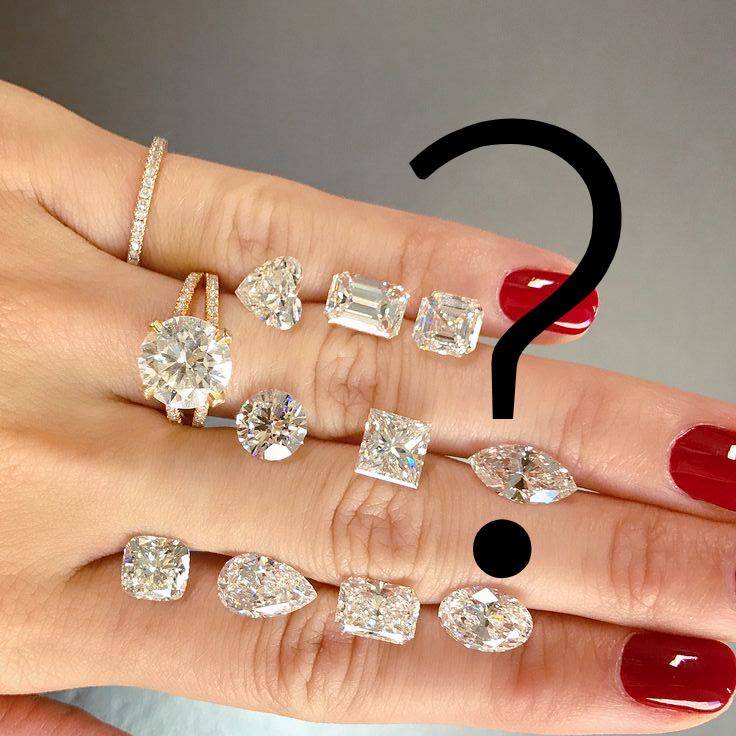The diamond girdle is an important part of the diamond. In summary, we discuss:
- Introduction
- Types of girdle finishing
- Brute finishing: Old method, Can cause inclusions and affect light performance
- Polished: Has an acceptable light performance
- Faceted: Has the best light performance
- Painting: Intentional cutting of some girdle portions thicker than others to save weight
- Digging out: Deliberately cutting some parts of the girdle thinner than others in order to remove inclusions
- GIA Grading of diamonds:
- Extremely thin: Very prone to breaking and chipping
- Very thin: Very good gemstone qualities
- Medium: Ideal diamond proportions
- Thick: Near-perfect girdle proportions
- Very thick: Undesirable thickness level
- Extremely thick: Very undesirable thickness level, exhibits the fisheye effect
- The fish eye effect occurs when the girdle thickness is increased so much that it reflects when viewed through the table of the diamond.
- Significance of the girdle to the diamond:
- The girdle can affect the light performance of the diamond
- It can affect the weight of the diamond
- The girdle finishing can also affect the light performance of the diamond
- Girdles can reflect in the table and cause the fisheye effect
- Inscriptions can be made on the girdle
- The girdle can affect the price
- It also affects the durability of the diamond.

The diamond girdle refers to the outer edge of the diamond. It is the diamond part that separates the crown above from the pavilion below.
As an important grading factor for GIA reports, it is expedient to understand the Girdle and how it affects your diamond.
The thickness of the girdle can be expressed in percentage and this is measured as a percentage of the diameter of the diamond.
TYPES OF DIAMOND GIRDLE FINISHING
The girdle can be faceted, bruted or polished. The grading report would usually report the girdle type of the diamond.
A bruted girdle is one that has its ends rounded by abrading against another diamond. It gives the diamond a frosty, grainy look. It is not as common as it was before and has a disadvantage of causing feathers (inclusions) or cracks during abrading. This can diminish the quality and performance of the stone. It can also cause a gray reflection to appear under the table if it is thick enough.
A polished girdle refers to one that is polished into a single facet and allows a view into the stone. In reality, a polished girdle is actually a bruted girdle that has been polished smooth to remove all the cracks or inclusions. A polished girdle is seen commonly in step cuts like the princess cuts. It has acceptable light performance.
The Faceted girdle is now in vogue and this type of girdle has several facets, which gives the diamond a neater look and better finish. Typically, faceting would also involve abrading and whatever cracks or feathers are created during the process are removed during faceting. Brilliant cuts usually have the faceted type of girdle finishing. This type of finishing blends well with the other facets of the cut and allows for maximal light performance and sparkle. It is also the recommended type of girdle finishing.
From this, it is obvious that the faceting technique would be the most difficult and would require expertise. However, it is the most popular today.
It is noteworthy that a diamond girdle’s finish is not supposed to be conspicuous on visual inspection except it is too thick or the diamond is extremely large.
Painting: Another term associated with diamond girdles. Painting refers to the intentional cutting of the diamond girdle into unequal portions, usually to save weight. In painting, some parts are cut thicker than others.
Very closely related to painting is digging out. Digging out refers to when diamond cutters deliberately cut some parts of the diamond girdle thinner than others. This is usually done to chip off parts that contain very unattractive inclusions.
Either way, when painting or digging out is done, the diamond can have an unevenly cut girdle and this can affect the shape of the diamond, especially when viewed face-up. When the painting is severely done, the diamond might have white flashes when viewed and it might also appear uneven. When digging out is also extensively carried out, the lower portions of the diamond might appear dark and the diamond might also look smaller.
GIA GRADING OF DIAMOND GIRDLES
Like other components, the GIA provides a well-detailed report of the girdle of a diamond. This grading is based on the assessment of the thinnest and thickest portions of the diamond girdle. This is done by assessing the diamond through a microscope and the measurements are taken are then expressed in percentages relative to the diameter of the diamond. After this, the final grade is assigned by visual inspection. The diamond is viewed from a face-up position and then at different angles to assign the grade.
Based on the above method, GIA has graded diamond girdles into:
- Extremely Thin: This grade of girdles has an extremely small outline. In fact, they are almost not visible on inspection. This grade is also associated with breaking and chipping and should be handled with care when setting into stone. Diamonds with this grade of girdles might also appear shallow.
- Very Thin: This grade has small outlines. The outlines are also at risk of chipping or breaking and should be handled with care while setting the stone. The Very thin grade has very good gemstone qualities and is the choice girdle size for most excellent and very good cuts.
- Medium: The medium grade has the ideal proportions for diamond girdles. It is the perfect girdle and there is a significantly reduced risk of chipping or breaking because this particular girdle type is sufficiently thick to withstand some pressure without being too thick to affect the diamond’s depth. Some modifications to this grade can be made, such that we now have a thin – medium combination.
- Slightly Thick: This grade is an almost perfect one. The thickness of the girdle is higher than the medium but does not also affect the depth of the diamond – it is not too deep as a result of the girdle. There is also minimal risk of chipping or breaking with this girdle grade.
- Thick: According to the GIA, this grade has a thickness that is higher than what is desirable for an ideal diamond. The thickness can affect the appearance of the diamond because it increases the depth of the diamond.
- Very thick: With this girdle grade, there is a higher level of thickness than is desired. There would be a significant increase in depth, which makes the diamond appear shallow. Furthermore, the cut grade of the diamond would be reduced to Good.
- Extremely thick: This girdle grade is very undesirable. The level of thickness is so high that it reduces the cut grade to fair. The diamond is also very deep and looks smaller because the girdle takes up a lot of the depth. An extremely thick girdle can also result in what is known as the ‘Fisheye effect’.
So, what is the FISH EYE EFFECT?
The fish eye effect refers to a phenomenon seen in diamonds with extremely thick girdles. There is an observed reflection of the girdle of the diamond when it is viewed from the top through the table. This has a negative effect on the sparkle and brilliance of the diamond. The resulting reflection would look like a large circular inclusion, hence the name ‘fish eye.’
Recall that we said the diamond girdle is assessed based on its thinnest and thickest portions. Therefore, the grading of the diamond girdle is usually a range. For instance, ‘Very thin – Slightly thick.’
The reason for this is to accommodate for the variations between the thinner and thicker portions of the diamond girdle. If this variation is large, the diamond’s symmetry would be affected and it would appear disproportionate.
Significance of the girdle to the diamond
- It can affect the light performance: When a girdle is too thick, it would make the diamond too deep and as a result, there would be poor light return. The light coming into the diamond would escape through the pavilion instead of being reflected in the observer.
- It can affect the weight: A thicker girdle would obscure the weight of the diamond. A similar diamond of equal carat, but with a thinner girdle would appear larger. This is because an extremely thick girdle would hide the weight as depth!
- The girdle finishing can affect the light performance of the stone: Faceted finishing has the best light performance.
- Girdles can reflect in the table and cause the fisheye effect
- Girdles can also serve inscription purposes. The identification number of a diamond (if it has one) can be inscribed with lasers on the girdle.
- The girdle of a diamond can affect its price. If it is thick enough to reduce the size, then it might be priced lower than a diamond of similar carat but larger size. The poor light performance also reduces value.
- It also affects durability: Extremely thin Diamond girdles are at risk of breaking or chipping off.


